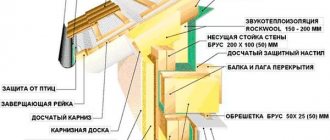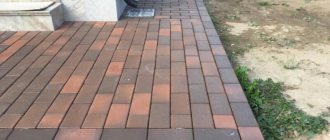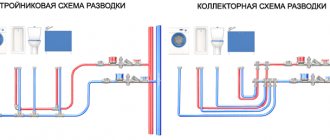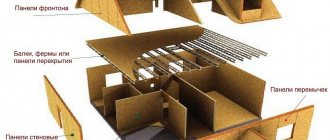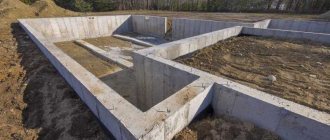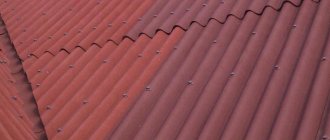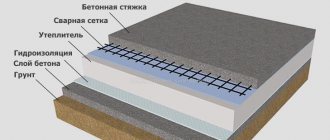Glass wool is a type of mineral wool and belongs to the category of thermal insulation materials (according to GOST 31913-2011 and EN ISO 9229:2007 standard). In terms of its structure and origin, glass wool is a fiber obtained from waste from the glass industry, mostly from broken glass. The main characteristics of the material are reduced to significant resistance to elevated temperatures and chemical influences. Glass wool insulation has good sound and heat insulation properties.
How does fiberglass insulation differ from other types of mineral wool? First of all, the source of origin. Glass wool is made from molten glass, which contains borax, limestone, dolomite, sand, and soda in the list of raw materials. Rock wool, in turn, is made from rocks after an eruption, and slag wool, respectively, from molten metallurgical slag. In the construction industry, glass wool insulation is very popular for cladding surfaces, including uneven ones. Fiberglass boards and mats can be used in structures of various configurations and shapes.
Technological nuances of glass wool production
When this type of insulation is produced, fiberglass goes through several stages.
- In a percentage ratio of 80% to 20%, cullet and a raw material mixture of sand, dolomite, soda, ethibor, limestone are taken and loaded into a hopper for melting.
- The melting phase consists of heating the mass to 1400°C, the contents of the melting furnace have strict proportions according to the recipe in order to obtain thin strands of glass wool, the insulation will have certain mechanical properties.
- Treatment with polymer aerosols results in the formation of fibers. Each impregnated thread goes along a conveyor, leveling out and gradually turning into a “carpet” of glass wool.
- The next stage is polymerization. The temperature changes to 250°C as heat catalyzes the polymer bonds. At the same time, the remaining aerosol moisture evaporates in the temperature chamber. At the output we have bright yellow and frozen glass wool , the insulation then goes to the cooling stage.
- Cooling to room temperature, cutting with cutters and saws along and across, respectively, are the final stages of the production of fiberglass insulation. The mats and rolls that we are used to seeing in hardware stores are made from an endlessly long ribbon of glass fibers.
Properties of glass wool
Glass wool insulation is special in terms of key characteristics:
- The fiber thickness is only 3 to 15 micrometers ;
- the fiber length of glass wool is up to 4 times longer than the length of its stone counterpart;
- the known strength and elasticity of the material is related precisely to the size of the fibers;
- very high resistance to vibration, fiberglass does not have non-fibrous compounds in its structure;
- the thermal conductivity value ranges from 0.030 to 0.052 W/(m K);
- the material can withstand up to 450°C.
Objects on which fiberglass insulation is applied for thermal insulation are walls and ceilings, high-temperature surfaces such as pipelines, industrial tanks and furnaces, and structures requiring fire safety. These can be vertical, horizontal and inclined surfaces. As sound insulation, the material can be found in acoustic screens and partitions .
Useful: Tool for building a frame house
Density and mass of materials
Density affects the mass of a material. The denser the slab, the more weight it will have on the insulated structures. Glass wool has a density from 11 to 200 kg/m3. Stone wool is produced with a density of 15-220 kg/m3.
With the same roll sizes, stone wool is denser and is clearly in the lead, but this victory has a second side - weight. In the case of a ceiling, second floor floor or walls, basalt slabs will exert greater pressure on the structures underneath, which must be taken into account at the design stage.
What are fiberglass products?
A number of mounting products are made from glass wool:
- soft mats;
- soft, semi-soft and hard boards with a synthetic binder, the last two insulation options can withstand heavy loads ;
- For wind protection, slabs of increased rigidity with glass felt lining have been developed.
The slabs on the long sides can be attached to each other in tongue and groove. The manufacturer chose these types of connections to eliminate gaps and increase reliability. A tongue is a longitudinal protrusion that fits into a groove of the desired shape located on an adjacent slab. Tongue connection is a type of mating of fiberglass insulation boards in which the segments are connected in the form of a tongue-and-groove lock.
Soft material is sold in rolls, as it is convenient for transportation and installation. When the package is opened, the elastic fibers straighten out on their own and quickly reach their original volume. In the assortment you can find thermal insulation made of glass wool with lamination, that is, with the application of an additional layer of foil for vapor insulation or fiberglass for protection from wind . Lamination of glass wool insulation is designed to prevent fiber migration. In terms of manufacturers, it is worth noting well -known brands on the market: Ursa, Knauf, Isover, Neman.
Health effects of fiberglass insulation
Following research in Europe into the potentially hazardous effects of mineral wool, an EU directive was issued in 1997. It examines mineral wool varieties according to the degree of carcinogenic hazard: the second group of the classifier means the presence of potentially dangerous irritants, that is, irritants, and the third group - that the collected data is not enough for a full conclusion on carcinogenicity. The main criteria by which the degree of health hazard was determined were the size of the fibers and the content of alkaline earth and alkali metal oxides.
In 2001, IARC (International Agency for Research on Cancer) reported on the analysis of the carcinogenicity of fiberglass insulation - it fell into the third group according to the degree of danger to human health. This means that there is no sufficient evidence of a mutagenic effect on the cells of a living organism .
Main advantages
- High rates of thermal insulation and sound insulation. A wall insulated with fiberglass insulation can retain up to 40 dB of noise.
- The natural components that make up glass wool (mineral wool) are the key to its environmental cleanliness and safety for human health.
- Fiberglass insulation does not burn. It can withstand heating up to 4500C.
- Glass wool is not destroyed by vibration, is not subject to rotting and molding, and rats and mice will not breed in it.
With all the listed advantages, glass wool has a very affordable price.
What to do if you are injured by fiberglass
Specific disadvantages of glass wool thermal insulation boil down to the high degree of fragility of the fiber. This leads to the formation of extremely thin and sharp chips that penetrate the human skin, causing it to itch. Glass wool particles from the insulating layer can penetrate clothing, after which they are almost impossible to remove. Specialists working with fiberglass insulation wear tight overalls, do not allow the formation of open skin, and need a respirator, safety glasses and gloves. It is very dangerous for fiberglass particles to get into the eyes and lungs; this will cause inevitable irritation of the organs.
There are first aid rules for unsuccessful handling of fiberglass insulation:
- When glass wool comes into contact with the skin, do not scratch the itchy areas ;
- The particles are very carefully shaken off the hair, then the eyes are closed and the head is lowered into a bath or large container without water, shaken off with a movement of the neck;
- taking a cold shower without any detergents or washcloths under strong water pressure is the next step; hot water expands pores, so it is not used;
- if a fiberglass irritant gets into your eyes, they should be rinsed with a stream of cold water , after which you must consult an ophthalmologist, perhaps even call an ambulance or go to an eye surgery if you feel unwell;
- if a person has inhaled glass wool fragments and experiences symptoms of difficulty breathing and coughing, they should definitely see a doctor;
- contaminated clothing is thrown away , since even repeated washing will not completely remove glass wool fragments.
Advantages and disadvantages of glass wool
It is impossible to imagine a full review of insulation without comparing the pros and cons of the material. So, glass wool is chosen for thermal and sound insulation of surfaces for several reasons. This type of insulation with fiberglass in its composition is cost-effective, elastic and does not transfer heat well. In addition, due to its elasticity, the material is able to take the desired shape - from flexible and soft coverings to rigid and semi-rigid panels. Also, technologically advanced and lightweight glass wool can be mounted on hinged ventilated facades, outside on walls under “wet plaster”, in frame-panel construction to fill structures.
Useful: Frame garage: step-by-step construction instructions
However, no matter how honest the manufacturer is, he will remain silent about several significant disadvantages of fiberglass insulation. But experts with many years of experience talk about them honestly. We are talking about increasing thermal conductivity when the insulation is moistened. Drying wet areas is very difficult, up to several months. The problem is solved by completely replacing the wet insulation with a new dry layer. Therefore, glass wool as insulation is not always considered as an economical option, especially if there is a clear risk of exposure to moisture.
Material shrinkage is the second obvious disadvantage. During the period of operation, the insulation develops cracks that allow heat to pass through. Compaction will not help in this case, since the compressed glass fiber loses its efficiency, increasing thermal conductivity. And there is a third point - the installation of fiberglass insulation is technologically simple, but requires compliance with safety precautions. Microparticles of glass should not get on the skin , respiratory and visual systems, for which protective clothing is used. When installing a glass wool insulation layer, it is necessary to ensure adequate exhaust ventilation. There are no environmental safety claims regarding glass wool.
Summarizing all the advantages and disadvantages of fiberglass insulation material, we can conclude: it is advisable to buy glass wool if you have a limited budget, careful selection of the manufacturer and the ability to ensure competent and technically perfect installation.
Performance Comparison
In order to reliably decide which is better, a basalt slab or mineral wool, it is necessary to compare the most important indicators, which we will include:
- price;
- thermal insulation qualities;
- gyroscopicity and vapor permeability;
- durability;
- environmental friendliness;
- noise insulation performance;
- fire safety;
- ease of installation;
- attractive to rodents and resistant to mold.
Having determined these criteria, it will be possible to draw a conclusion which insulation is better and what to choose for each specific case.
Which is cheaper?
Mineral wool is sold at prices ranging from 1200 to 1400 rubles/m3. The cost of basalt insulation is from 1450 to 2250 rubles/m3. Installation prices are the same. In addition, laying the slabs is not at all difficult to do yourself.
It turns out that mineral wool is 20-25% cheaper than basalt , which, with a limited budget, can become the most important factor. However, it should be taken into account that cheaper material has worse performance qualities and this will lead to serious financial losses in a few years.
Which is warmer
The thermal conductivity coefficient of basalt mats is 0.035-0.042 W/(m×°K), glass wool 0.038-0.046 W/(m×°K). That is, in terms of this indicator, both thermal insulation materials are almost the same . Therefore, choosing based on thermal conductivity simply does not make sense. In addition, as practice has shown, most manufacturers produce their products with a thermal conductivity coefficient below the average declared level.
Hygroscopicity and vapor permeability
The water absorption rate of basalt mats is close to zero. Glass wool actively absorbs moisture, while losing its thermal insulation properties and changing its original shape. The vapor permeability or ability to allow air to pass through is the same for both insulation materials. But here it should be taken into account that if mineral wool mats are wrapped in plastic film to protect them from moisture, then their vapor permeability will completely disappear.
According to these parameters, basalt insulation should be considered the best.
Which is more durable?
In absolutely dry operating conditions, glass wool can last up to 30 years . After this, due to crystallization processes, the material will collapse. But, as reality shows, mineral wool insulation rarely lasts more than 10 years. The main reason is the absorption of moisture from the air and, as a result, acceleration of the crystallization process.
Manufacturers of stone wool claim a 50-year service life, although the material began to be produced a little over 25 years ago. There is no real data yet, just as there is no information about forced replacements of insulation.
Purchasing more expensive basalt mats may be more profitable, since the material does not require replacement for a long time and does not lead to additional costs in the future.
Environmental friendliness
Both materials have no components harmful to health. However, the binders contain 3-4% formaldehyde resin. Therefore, a number of experts consider both insulation materials to be potentially dangerous to humans, not taking into account that formaldehyde begins to emit up to 2.5% of harmful substances from its volume only when heated to more than 30°C.
Therefore, we can confidently conclude that in real conditions both insulation materials can be used in residential construction without restrictions .
Noise insulation
Both materials effectively dampen sound vibrations. For basalt this figure is higher, but not significantly. Therefore, this indicator can not be taken into account when choosing insulation.
Fire safety
In terms of fire safety, both materials belong to the non-flammable class and can only decompose at temperatures above the maximum permissible.
Which is easier to install?
The installation technology itself is absolutely the same. However, when working with glass wool, you will have to worry about protecting your eyes and respiratory system. At the same time, basalt mats also emit dust during operation, although, according to experts, it is safe for health. We described the installation technology using a ceiling as an example here.
What is better at resisting mold?
Both insulation materials do not contribute to the development of mold and mildew. But basalt material does not attract rodents at all, but they live very willingly in glass wool.

